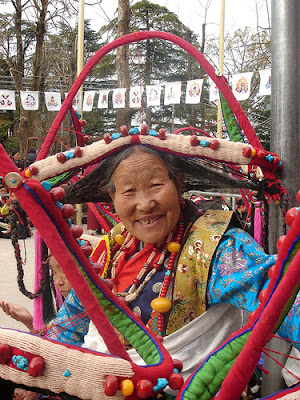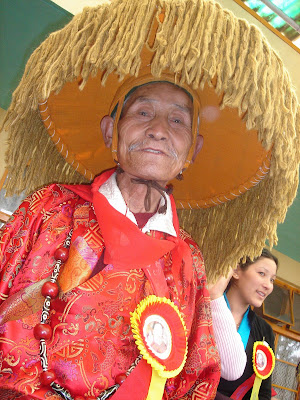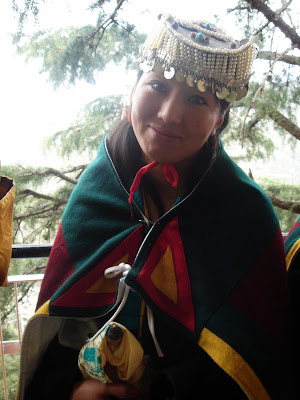Singin' in the rain
McLeod Ganj, Dharamsala
Has it really been a week since I wrote on the blog? -- unbelievable.
Yet, there is the evidence, in front of my eyes, on the Tibetan Rigpa calendar
(another calendar to keep track of - in addition to Hindu and Newari dates).
It's the year 2134 in Tibetan time.
The weather is really crazy- today we had:
1-cloudy morning,
2-heavy rainfall, then
3-beautiful sun WHILE it was raining
4- a rainbow
5-a hailstorm while sun came out and
6-around 6pm, yet another hailstorm, this time literally the size of moth-balls. You could have put an ice bucket out on the terrace and filled it quickly. I really thought it might break the windows!
and finally -
7-More lovely sun and another rainbow, only to be followed by
8-a late-night shower.
Tibetan tradition, like Indian and Nepali tradition, does everything by astrology (they have their own system which is a cross between Chinese and Indian astrology). This year is "an obstacle year" for His Holiness the Dalai Lama. In fact, for anyone turning 73 their 73rd year is considered an 'obstacle' year. So, there are extra "long-life" ceremonies being offered for him, for the past week. I call it "extra special very auspicious healthy lucky long life merit puja" (a take-off on the way Indians love to embellish things!).
Yesterday was quite remarkable - about a thousand (literally) Tibetans came all the way from Nepal and western Tibet regions to offer stuff (elaborate hand-made gilded Buddha and deity statues, sacks of rice, potted flowers, precious sacred Tibetan texts printed on the traditional long-paper and wrapped in silk, hand-woven
carpets, bolts of brocade and so on).
Hundreds of the old folks dressed in their "traditional dress" which looks
like a rainbow-striped circus crossed with Native Americans from outer space (don't know how else to describe it, really).
Sacred Stomping
As HH came into the temple, they started dancing. Tibetan folk dances look a great deal like Native American dances (small steps from side to side, moving in a circle and spiral). Like a lot of folk dances, the individual steps were not so remarkable - it's when seen in a large group that it really makes an impact. The ladies looked like a moving, shifting wall of rainbow colours. The men, in their heavy boots, stamp and whirl with long sleeves outstretched, resembling eagles' wingspans.
look a great deal like Native American dances (small steps from side to side, moving in a circle and spiral). Like a lot of folk dances, the individual steps were not so remarkable - it's when seen in a large group that it really makes an impact. The ladies looked like a moving, shifting wall of rainbow colours. The men, in their heavy boots, stamp and whirl with long sleeves outstretched, resembling eagles' wingspans.
They dance in a large circle, facing the centre, where a single drummer (always male) pounds the very simple beat - again, a lot like Native American music. It feels very shamanic and tribal. Of course, now in addition to the drummer there is a
videographer. So, at least one thing has changed in the tradition. I reflected on how they probably used to dance around a fire. Now, they dance around a camera!
They always sing while dancing. The men start their vocals, low and earthy. Then after a verse or so the women come in with their soaring singing and it sounds like the sky meeting the earth. What it must be like to see these dances on the open steppes under the endless blue sky of Tibet!
Most of the dancers were 50 yrs old or older, and one probably never sees such a gathering of traditional Tibetan attire even in Tibet, these days.
Wizards of Weather
To get my photographer's press pass for tomorrow's Extra Special Lucky Puja, I had to go allll the way down to "the library," which is the name for Lower Upper Dharamsala where the Tibetan Govt. offices are. (There's Lower Dharamsala, Upper Dharamsala / McLeod Ganj, and then what I call "lower Upper Dharamsala" below the temple, "Middle Upper Dharamsala" and "upper Upper Dharamsala" - above the main road). I was helped by a sweet-natured fifty-something Tibetan woman named Sonam Wangmo. It turns out she attended NYU on a Fullbright scholarship.
which is the name for Lower Upper Dharamsala where the Tibetan Govt. offices are. (There's Lower Dharamsala, Upper Dharamsala / McLeod Ganj, and then what I call "lower Upper Dharamsala" below the temple, "Middle Upper Dharamsala" and "upper Upper Dharamsala" - above the main road). I was helped by a sweet-natured fifty-something Tibetan woman named Sonam Wangmo. It turns out she attended NYU on a Fullbright scholarship.
We discussed the crazy weather (always a fecund topic for conversation here) and she casually mentioned, "You know, maybe we should call a Ngagpa. Do you know what a Ngagpa is?" (pronounced "nakpa").
I did indeed. "A Ngagpa is a kind of Tibetan sorcerer or wizard."
"Yes, they can stop the rain - or make it rain, or snow. They can control the weather."
"Perhaps you should have one on staff!" I half-joked. Really, it would be a good idea.
"Yes...but you know," she added on second thought, "we do need the rain. Water is such a problem always here in Dharamsala." It is one of the weirdnesses of the locale that a place receiving so much rainfall (#2 rainfall in India, after Cherrapunji) also suffers from water shortages.
The whole conversation was very matter-of-fact -- as though Sonam had been discussing the pros and cons of hiring a particularly difficult plumber.
It is really lightning out and I have to walk back to the village before it starts raining AGAIN!
McLeod Ganj, Dharamsala

Has it really been a week since I wrote on the blog? -- unbelievable.
Yet, there is the evidence, in front of my eyes, on the Tibetan Rigpa calendar
(another calendar to keep track of - in addition to Hindu and Newari dates).
It's the year 2134 in Tibetan time.
The weather is really crazy- today we had:
1-cloudy morning,
2-heavy rainfall, then
3-beautiful sun WHILE it was raining
4- a rainbow
5-a hailstorm while sun came out and
6-around 6pm, yet another hailstorm, this time literally the size of moth-balls. You could have put an ice bucket out on the terrace and filled it quickly. I really thought it might break the windows!
and finally -
7-More lovely sun and another rainbow, only to be followed by
8-a late-night shower.
Tibetan tradition, like Indian and Nepali tradition, does everything by astrology (they have their own system which is a cross between Chinese and Indian astrology). This year is "an obstacle year" for His Holiness the Dalai Lama. In fact, for anyone turning 73 their 73rd year is considered an 'obstacle' year. So, there are extra "long-life" ceremonies being offered for him, for the past week. I call it "extra special very auspicious healthy lucky long life merit puja" (a take-off on the way Indians love to embellish things!).
Yesterday was quite remarkable - about a thousand (literally) Tibetans came all the way from Nepal and western Tibet regions to offer stuff (elaborate hand-made gilded Buddha and deity statues, sacks of rice, potted flowers, precious sacred Tibetan texts printed on the traditional long-paper and wrapped in silk, hand-woven
carpets, bolts of brocade and so on).
Hundreds of the old folks dressed in their "traditional dress" which looks
like a rainbow-striped circus crossed with Native Americans from outer space (don't know how else to describe it, really).
Sacred Stomping
As HH came into the temple, they started dancing. Tibetan folk dances
They dance in a large circle, facing the centre, where a single drummer (always male) pounds the very simple beat - again, a lot like Native American music. It feels very shamanic and tribal. Of course, now in addition to the drummer there is a
videographer. So, at least one thing has changed in the tradition. I reflected on how they probably used to dance around a fire. Now, they dance around a camera!
They always sing while dancing. The men start their vocals, low and earthy. Then after a verse or so the women come in with their soaring singing and it sounds like the sky meeting the earth. What it must be like to see these dances on the open steppes under the endless blue sky of Tibet!
Most of the dancers were 50 yrs old or older, and one probably never sees such a gathering of traditional Tibetan attire even in Tibet, these days.
Wizards of Weather
To get my photographer's press pass for tomorrow's Extra Special Lucky Puja, I had to go allll the way down to "the library,"
We discussed the crazy weather (always a fecund topic for conversation here) and she casually mentioned, "You know, maybe we should call a Ngagpa. Do you know what a Ngagpa is?" (pronounced "nakpa").
I did indeed. "A Ngagpa is a kind of Tibetan sorcerer or wizard."
"Yes, they can stop the rain - or make it rain, or snow. They can control the weather."
"Perhaps you should have one on staff!" I half-joked. Really, it would be a good idea.
"Yes...but you know," she added on second thought, "we do need the rain. Water is such a problem always here in Dharamsala." It is one of the weirdnesses of the locale that a place receiving so much rainfall (#2 rainfall in India, after Cherrapunji) also suffers from water shortages.
The whole conversation was very matter-of-fact -- as though Sonam had been discussing the pros and cons of hiring a particularly difficult plumber.
It is really lightning out and I have to walk back to the village before it starts raining AGAIN!














3 comments:
Thanks for bringing back McLeodganj for me. Was there, oh fifteen or more years ago (Any pictures coming?) and I remember the "wearing every item of clothing" bit. Brr. Was there during a hailstorm.
Have a fun siren!!!!You photos from Niranjana On Flickr is great...keep it up...I am regularly reading your blogs here
Luv the hear gear these women are wearing :P
Post a Comment